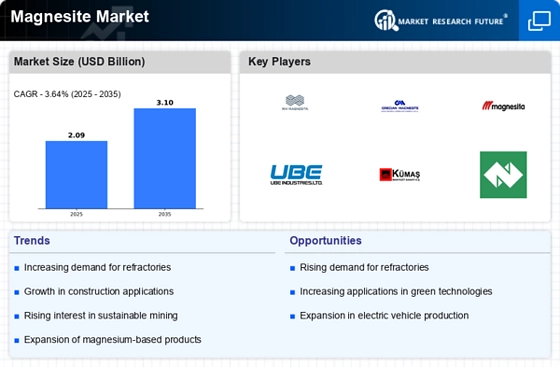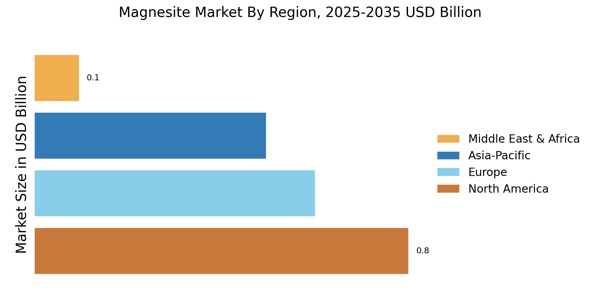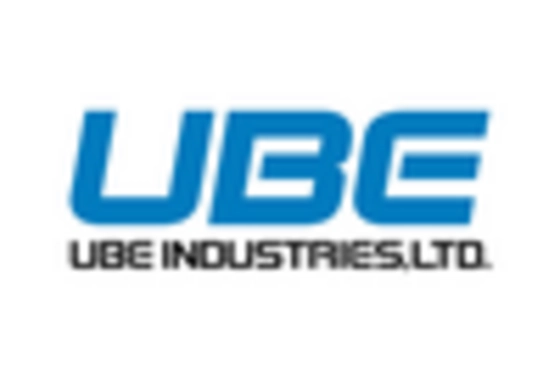Increasing Use in Agriculture
The Magnesite Market is witnessing a growing interest in the use of magnesite in agricultural applications. As soil health becomes a focal point for sustainable farming practices, magnesite is recognized for its potential benefits as a soil amendment. It provides essential magnesium, which is vital for plant growth and development. Recent studies indicate that the application of magnesite can enhance soil fertility and improve crop yields, making it an appealing option for farmers. The agricultural sector has been increasingly adopting magnesite to address soil deficiencies, which could lead to a rise in demand for this mineral. This trend suggests that the magnesite market may diversify its applications, tapping into the agricultural sector as a new growth avenue, thereby broadening its overall market potential.
Rising Demand for Refractories
The Magnesite Market is experiencing a notable increase in demand for refractories, which are essential materials in high-temperature industrial processes. This demand is primarily driven by the steel and cement sectors, which utilize magnesite-based refractories for their superior thermal stability and resistance to corrosion. In recent years, the refractories segment has accounted for approximately 60% of the total magnesite consumption, indicating a robust market trend. As industries continue to expand, the need for efficient and durable refractory materials is likely to grow, further propelling the magnesite market. Additionally, the shift towards more sustainable production methods in these industries may enhance the appeal of magnesite refractories, as they are often derived from natural sources, aligning with environmental regulations and corporate sustainability goals.
Growth in Construction Activities
The Magnesite Market is poised to benefit from the ongoing growth in construction activities across various regions. As urbanization accelerates, the demand for construction materials, including magnesite-based products, is expected to rise. Magnesite Market is utilized in the production of cement and concrete, which are fundamental components of modern infrastructure. Recent data suggests that the construction sector has been expanding at a rate of approximately 5% annually, creating a favorable environment for magnesite consumption. Furthermore, the increasing focus on energy-efficient buildings and sustainable construction practices may lead to a higher adoption of magnesite in building materials, thereby enhancing its market potential. This trend indicates a promising outlook for the magnesite market, as it aligns with the broader objectives of sustainable development and infrastructure improvement.
Technological Innovations in Extraction
Technological advancements in the extraction and processing of magnesite are significantly influencing the Magnesite Market. Innovations such as automated mining techniques and advanced processing methods have improved the efficiency and cost-effectiveness of magnesite production. These developments not only enhance yield but also reduce environmental impact, making magnesite a more attractive option for various applications. For instance, the introduction of selective mining techniques has allowed for the extraction of higher purity magnesite, which is crucial for high-performance applications. As these technologies continue to evolve, they are likely to drive down production costs and increase the availability of magnesite, thereby expanding its market reach. The integration of these innovations into the industry may also foster competition, leading to better quality products and services for consumers.
Environmental Regulations Favoring Natural Minerals
The Magnesite Market is likely to benefit from stringent environmental regulations that favor the use of natural minerals over synthetic alternatives. As industries face increasing pressure to reduce their carbon footprint, the demand for eco-friendly materials is on the rise. Magnesite Market, being a naturally occurring mineral, aligns well with these regulatory trends, making it a preferred choice for various applications, including refractories and construction materials. The shift towards sustainable practices is prompting manufacturers to seek out natural resources that comply with environmental standards. This regulatory landscape may enhance the attractiveness of magnesite, potentially leading to increased investments in its extraction and processing. As companies strive to meet sustainability goals, the magnesite market could see a significant uptick in demand, driven by the need for compliant and environmentally friendly materials.


















Leave a Comment